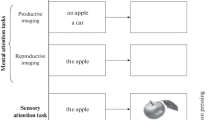Abstract
We test the possible multifractal properties of dominant EEG frequency components, when a subject tracks a path on a map, either only by eyes (imaginary movement – IM) or by visual-motor tracking of discretely moving spot in regular (RM) and Brownian time-step (BM) (real tracking of moving spot). We check the hypotheses that the fractal properties of filtered EEG (1) change with respect to the law of spot movement; (2) differ among filtered EEG components and scalp sites; (3) differ among real and imaginary tracking. Sixteen right-handed subjects begin to perform IM, next – real spot tracking (RM and BM) following a moving spot on streets of a citymap displayed on a computer screen, by push forward/backward a joystick. Multichannel long-lasting EEG is band-pass filtered for theta, alpha, beta and gamma oscillations. The Wavelet-Transform-Modulus-Maxima-Method is applied to reveal multifractality [local fractal dimensions D max(h)] among task conditions, frequency bands and sites. Non-parametric statistical estimation of the fractal measures h D max is finally applied. Multifractality is established for all experimental conditions, EEG components and sites as follows among filtered components – anticorrelation (h Dmax < 0.5) in beta and gamma, and long-range correlation (h Dmax > 0.5) for theta and alpha oscillations; among tasks – for RM and BM, h Dmax differ significantly whereas IM resembles mostly RM; among sites – no significant difference for local fractal properties is established. The results suggest that for both imaginary and real visual-motor tracking a line, multifractal scaling, specific for lower and higher EEG oscillations, is a very stable intrinsic one for the activity of large brain areas. The external events (task conditions) insert weak effect on the scaling.
Similar content being viewed by others
References
Amaral LAN, Ivanov PCh, Aoyagi N, Hidaka I, Tomono S, Goldberger AI, Stanley HE, Yamamoto Y (2001) Behavioral-independent features of complex hearbeat dynamics. Phys Rev Lett 86(26):6026–6029
Basar E, Basar-Eroglu C, Demiralp T, Schurmann M (1995) Time and frequency analysis of the brain’s distributed gamma band system. IEEE Eng Med Biol 14:400–410
Bell AJ, Sejnowski TJ (1995) An information-maximization approach to blind separation and blind deconvolution. Neural Comput 7:1129–1159
Chen Z, Hu K, Carpena P, Bernaola-Galvan P, Stanley HE, Ivanov PCh (2005) Effect of nonlinear filtres on detrended fluctuation analysis. Phys Rev E 71:011104
Dawson KA (2004) Temporal organization of the brain: neurocognitive mechanisms and clinical implication. Brain Cogn 54:75–94
Elbert T, Ray WJ, Kowalik ZJ, Skinner JE, Graf KE, Birbaumer N (1994) Chaos and physiology: Deterministic chaos in excitable cell assemblies. Physiol Rev 74(1):1–47
Gilden DL, Thornton T, Mallon MW (1995) 1/f noise in human cognition. Science 267:1837–1839
HuHu K, Ivanov PCh, Chen Z, Carpena P, Stanley HE (2001) Effect of trend on detrended fluctuation analysis. Phys Rev E 64:0111141–19
Hyvaerinen A, Karhunen J, Oja E (2001) Independent component analysis. Wiley, New York, pp 211–219
Ivanov PCh, Nunes Amaral LA, Goldberger AL, Havlin S, Rosenblum MG, Struzik ZR, Stanley HE (1999) Multifractality in human heartbeat dynamics. Nature 399:461–465
Ivanov PCh, Nunes Amaral LA, Goldberger AL, Havlin S, Rosenblum MG, Stanley HE, Struzik ZR (2001) From 1/f noise to multifractal cascades in heartbeat dynamics. Chaos 11(3):641–652
Jeong J, Joung M, Kim S (1998) Quantification of emotion by nonlinear analysis of the chaotic dynamics of electroencephalograms during perception of 1/f music. Biol Cybern 78:217–255
Jung T-P, Makeig S, McKeown MJ, Bell AJ, Lee T-W, Sejnowski TJ (2001) Imaging brain dynamics using independent component analysis. Proc IEEE 89 (7):1107–1122
Klimesh W, Schimke H, Schwaiger J (1994) Episodic and semantic memory: an analysis in theta and alpha band. Electroencephalogr Clin Neurophysiol 91:428–441
Kosslyn, SM, Ganis G, Thompson WL (2001) Neural foundations of imagery. Nat Rev Neurosci 2:635–642
MATLAB v. 5.3, The MathWorks Inc (1998)
Muzy JF, Bacry E, Arneodo A (1994) The multifractal formalism revisited with wavelets. Int J Bifurc at Chaos 4(2):245–302
Peng C-K, Havlin S, Stanley HE, Goldberger AL (1995) Quantification of scaling exponents and crossover phenomena in nonstationary heartbeat time series. Chaos 5:82–87
Popivanov D, Mineva A, Krekule I (1999) EEG patterns in theta and gamma frequency range and their probable relation to human voluntary movement organization. Neurosci Lett, 267:5–8
Popivanov D, Janyan A, Andonova E, Stamenov M (2003) Common dynamic properties of biosignal during cognition: self-similarity and chaotic dynamics of both response times and EEG during movement imagery. Nonlinear Dyn, Psychol Life Sci 7(4):315–328
Popivanov D, Stomonyakov V, Dojnov P (2004) Multifractality measures of EEG: diagnostic distinction in healthy subjects and aphasics during cognitive task. In: Singh M, Radhakrishnan S (eds). Advances in medical diagnostic techniques and procedures. Anamaya Publishers, New Delhi, pp 42–47
Popivanov D, Jivkova S, Stomonyakov V, Nicolova G (2005) Effect of independent component analysis on multifractality of EEG during visual-motor task. Signal Process 85:2112–2123
Poupard L, Sartene R, Wallet J-C (2001) Scaling behavior in β-wave amplitude modulation and its relationship to alertness. Biol Cybern 85:19–26
Wilson SM, Saygin AP, Sereno MI, Iacoboni M (2004) Listening to speech activates motor areas involved in speech production. Nat Neurosci June 6:S1097–S6256
Yordanova J, Kolev V, Demiralp T (1997) The phase-locking of auditory gamma band responses in humans is sensitive to task processing. Neuroreport 8:3999–4004
Author information
Authors and Affiliations
Corresponding author
Rights and permissions
About this article
Cite this article
Popivanov, D., Stomonyakov, V., Minchev, Z. et al. Multifractality of decomposed EEG during imaginary and real visual-motor tracking. Biol Cybern 94, 149–156 (2006). https://doi.org/10.1007/s00422-005-0037-5
Received:
Accepted:
Published:
Issue Date:
DOI: https://doi.org/10.1007/s00422-005-0037-5




